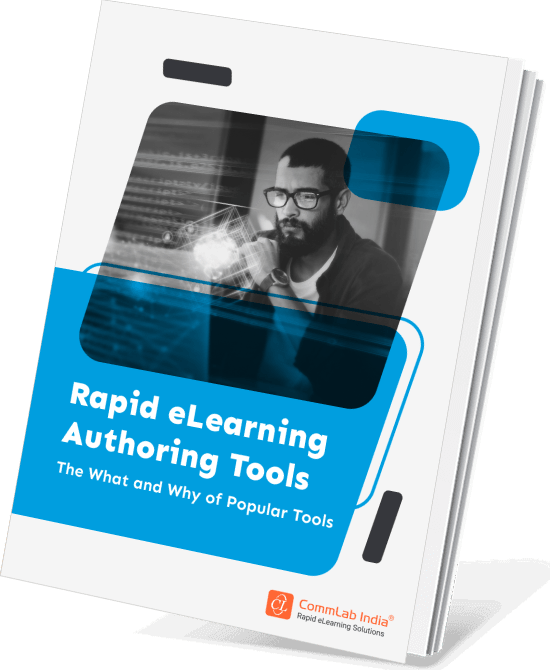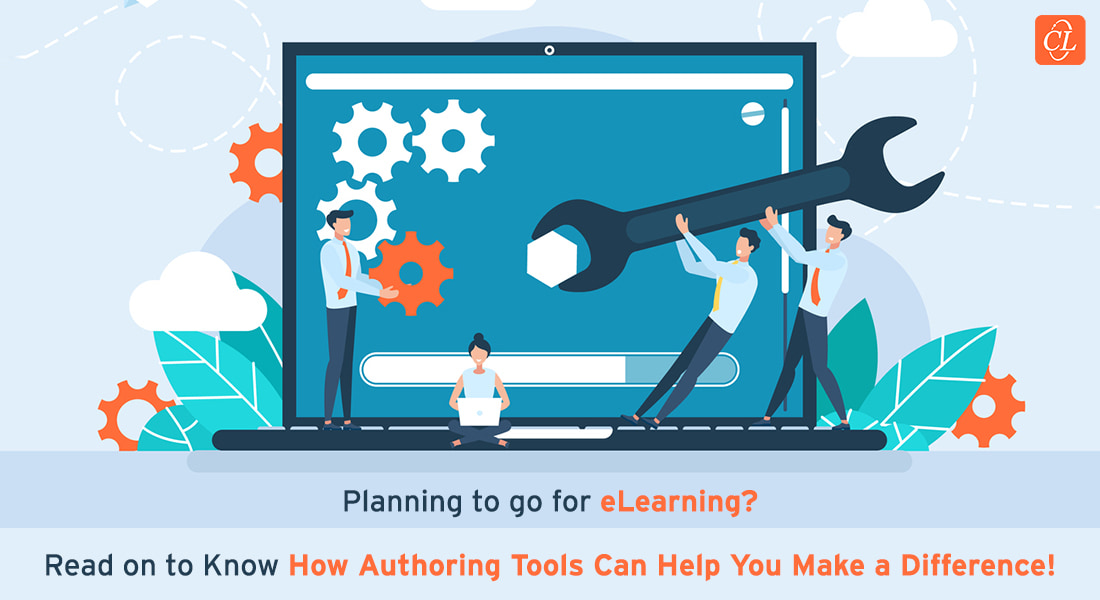eLearning Simulations and Top Tools to Develop Them

In the fast-paced world of eLearning, where attention spans are fleeting and learners crave interactive experiences, simulations emerge as a powerful tool to revolutionize the way we acquire knowledge and skills. Unlike traditional passive learning methods, learning simulations provide learners with hands-on opportunities to apply theoretical concepts in realistic scenarios, fostering deeper engagement, improved retention, and practical skill development. This blog explores the exciting world of eLearning simulations. We'll discuss their various benefits, the different types of simulations available, key considerations for developing them, and some of the top tools you can use to create your own.
→ Download eBook Now: Rapid eLearning Authoring Tools
Table of Contents
- What are The Benefits of Simulations in eLearning?
- What are the Various Types of eLearning Simulations?
- What are the Key Considerations for Developing eLearning Simulations?
- What are the Top Tools for Developing eLearning Simulations?
- What are the Best Practices for Designing Effective eLearning Simulations?
- What are Some Examples of Simulations in Implementation?
- What is the Future of eLearning Simulations?
What are The Benefits of Simulations in eLearning?
Simulations offer a plethora of advantages that make them a highly effective tool for eLearning. Let's delve into some of the key benefits:
1. Enhanced Engagement and Motivation
Simulations transform learning from a passive activity into an interactive and immersive learning experience. By allowing learners to actively participate in realistic scenarios, simulations capture their attention, spark curiosity, and foster a sense of ownership over their learning journey. This heightened engagement naturally leads to increased motivation and a desire to explore further.
2. Improved Knowledge Retention
Unlike traditional learning methods that often rely on rote memorization, simulations promote deeper understanding and knowledge retention. By providing learners with the opportunity to apply theoretical concepts in practical contexts, simulations help solidify learning and facilitate the transfer of knowledge to real-world situations.
Want to Start Developing with eLearning Simulations?
Here are a few popular tools
- Articulate Storyline 360
- Lectora Inspire
- iSpring
- CenarioVR
- Unity and Unreal Engine
3. Bridging the Gap Between Theory and Practice
Simulations serve as a vital link between what we learn in theory and how we apply it in practice. They provide learners with the opportunity to experiment, make choices, and observe the outcomes of their decisions within a secure and regulated setting. This experiential learning approach fosters the development of essential skills such as critical thinking, problem-solving, and decision-making, equipping individuals to tackle real-life challenges effectively.
4. Risk-free Learning Environments
Simulations offer a safe space for learners to make mistakes and learn from them without any real-world repercussions. This freedom to experiment and explore fosters a growth mindset and encourages learners to take risks, try new approaches, and push their boundaries.
5. Personalized Learning Experiences
Simulations can be tailored to meet the individual needs and preferences of learners. By providing adaptive feedback, branching scenarios, and customizable difficulty levels, simulations cater to different learning styles and paces, ensuring that each learner receives the optimal level of challenge and support.

6. Increased Accessibility and Inclusivity
ELearning simulations can break down barriers to learning and create more inclusive learning experiences. By offering alternative modes of interaction, such as text-to-speech, keyboard navigation, and closed captioning, simulations can cater to learners with diverse abilities and ensure that everyone has the opportunity to participate and succeed. Here’s a short video on understanding how you can create accessible eLearning with Articulate Storyline.
What are the Various Types of eLearning Simulations?
eLearning simulations come in various forms, each offering unique benefits and catering to different learning objectives. Let's explore some of the most common types:
1. Branching Scenarios
Branching scenarios present learners with realistic situations and prompt them to make decisions that influence the outcome. These simulations are particularly effective for developing critical thinking, problem-solving, and decision-making skills. By experiencing the consequences of their choices, learners gain valuable insights and learn to navigate complex situations.
2. Game-based Simulations
Game-based learning leverages the power of play to engage learners and make learning fun. By incorporating game elements such as points, badges, and leaderboards, these simulations tap into learners' intrinsic motivation and encourage them to actively participate. Game-based simulations are particularly effective for enhancing engagement, fostering collaboration, and promoting knowledge retention.
3. Virtual Reality (VR) Simulations
VR simulations immerse learners in virtual environments, providing them with a sense of presence and allowing them to interact with objects and characters in a realistic manner. These simulations are particularly beneficial for training in high-risk or complex environments, such as healthcare, aviation, and manufacturing. By providing a safe and controlled space for practice, VR simulations enable learners to develop practical skills and build confidence in their abilities.
4. Augmented Reality (AR) Simulations
AR simulations overlay digital information onto the real world, enhancing learners' perception and providing contextual information. These simulations are particularly useful for training in fields that require hands-on experience, such as maintenance, repair, and field service. By providing real-time guidance and support, AR simulations enable learners to complete tasks efficiently and effectively.
5. Software Simulations
Software simulations replicate real-world software applications, allowing learners to practice using specific tools and platforms in a safe and controlled environment. These simulations are particularly beneficial for technical training and onboarding new employees. By providing hands-on experience with software interfaces and functionalities, software simulations enable learners to develop proficiency and confidence in their skills.
6. Process Simulations
Process simulations guide learners through complex procedures step-by-step, providing them with the opportunity to practice each step and receive feedback along the way. These simulations are particularly effective for training in fields that involve intricate processes, such as manufacturing, engineering, and laboratory work. By breaking down complex tasks into manageable steps, process simulations enable learners to master procedures and avoid costly errors.
7. Social Simulations
Social simulations involve interacting with virtual characters and environments, allowing learners to practice communication, collaboration, and interpersonal skills in a safe and controlled setting. These simulations are particularly valuable for leadership development, customer service training, and conflict resolution. By providing opportunities for role-playing and practicing social interactions, social simulations enable learners to develop essential soft skills and build confidence in their ability to navigate interpersonal dynamics. As we have discussed about leadership just now, here are a few advantages of it.

What are the Key Considerations for Developing eLearning Simulations?
Creating impactful eLearning simulations requires careful planning and consideration of several crucial factors. Let's explore some of the key considerations that can contribute to the success of your eLearning simulation development initiatives:
- Learning Objectives: The first and most critical step is to clearly define your learning objectives. What specific knowledge, skills, or behaviors do you want learners to acquire or demonstrate after completing the simulation? By aligning your simulation design with clear learning objectives, you ensure that the experience is focused, purposeful, and delivers measurable outcomes.
- Target Audience: Understanding your learners is paramount. Consider their existing knowledge, skills, learning styles, and preferences. Tailor the simulation's content, complexity, and interactive elements to resonate with your target audience, ensuring it's both challenging and accessible.
- Storytelling and Narrative: A compelling narrative can significantly enhance the engagement and effectiveness of a simulation. Craft a story that immerses learners in the scenario, introduces relatable characters, and presents challenges that resonate with real-world experiences. A well-crafted narrative can capture learners' attention, evoke emotions, and create a memorable learning experience.
- Feedback and Assessment: Providing timely and constructive feedback is crucial for guiding learners' progress and reinforcing learning. Incorporate feedback mechanisms within the simulation that offer guidance, highlight areas for improvement, and celebrate successes. Additionally, include eLearning assessment tools that measure learners' understanding and skill acquisition, providing valuable insights into the effectiveness of the simulation.
- Accessibility: Ensure that your simulation is accessible to all learners, regardless of their abilities or disabilities. Consider incorporating features such as alternative text descriptions for images, keyboard navigation options, closed captioning for videos, and adjustable font sizes. Adhering to accessibility guidelines fosters inclusivity and ensures that everyone has an equal opportunity to participate and benefit from the simulation.
- Technology and Tools: Choosing the right technology and tools is essential for bringing your simulation vision to life. Consider factors such as ease of use, flexibility, scalability, compatibility with different devices, and cost-effectiveness. Evaluate various authoring tools, game engines, and VR/AR development platforms to select the one that best suits your needs and resources.

Rapid eLearning Authoring Tools
Explore the What and the Why of Popular Rapid eLearning Development Tools, and GenAI Tools
- Categories of eLearning Authoring Tools
- Considerations to Choose Your Next Authoring Tool
- Features of Popular Rapid Authoring Tools
- GenAI Tools to Create Content, Graphics, Audio, and Video
What are the Top Tools for Developing eLearning Simulations?
Choosing the right tool is crucial for bringing your eLearning simulations to life. With a wide array of options available, each with its own strengths and limitations, selecting the perfect fit for your needs can be overwhelming. To help you make an informed decision, let's explore some of the top tools for developing eLearning simulations:
1. Articulate Storyline 360
Articulate Storyline 360 is a versatile authoring tool that offers a comprehensive suite of features for creating interactive eLearning content, including simulations. With its intuitive interface, drag-and-drop functionality, and built-in templates, Storyline 360 empowers you to design engaging simulations without requiring extensive coding knowledge. Its robust features enable you to incorporate branching scenarios, interactive elements, multimedia, and assessments seamlessly into your simulations.
2. Adobe Captivate
Adobe Captivate is a powerful software solution renowned for its ability to create interactive eLearning experiences, including simulations. Captivate offers a range of advanced features, such as responsive design capabilities, VR simulation development, and integration with Adobe's Creative Cloud suite. Its flexibility and extensive feature set make it a popular choice for creating complex and sophisticated simulations.
3. Lectora Inspire
Lectora Inspire is a flexible authoring tool that provides a high degree of customization for building eLearning simulations. With its open architecture and support for HTML5, JavaScript, and CSS, Lectora Inspire empowers you to create unique and tailored simulations that align precisely with your vision. Its powerful features enable you to incorporate branching scenarios, interactive elements, multimedia, and assessments with ease.

4. Elucidat
Elucidat is a cloud-based authoring platform that facilitates collaborative simulation development. Its intuitive interface, real-time collaboration features, and built-in review and feedback tools streamline the simulation creation process, making it ideal for teams working remotely or across different locations. Elucidat's focus on accessibility ensures that your simulations are usable by all learners.
5. iSpring Suite
iSpring Suite is a user-friendly toolkit that integrates seamlessly with PowerPoint, enabling you to create eLearning simulations directly within the familiar PowerPoint environment. With its simple drag-and-drop interface and extensive library of interactive elements, iSpring Suite simplifies the simulation development process, making it accessible even for those with limited technical expertise.
6. CenarioVR
CenarioVR is a specialized tool specifically designed to create immersive VR simulations. Its intuitive interface, drag-and-drop functionality, and 360-degree media support simplify the development of VR experiences. CenarioVR's focus on creating realistic and interactive virtual environments makes it an ideal choice for training in high-risk or complex scenarios.
7. Unity and Unreal Engine
Unity and Unreal Engine are powerful game engines widely used for developing high-fidelity simulations and VR experiences. Their robust capabilities, extensive asset libraries, and advanced scripting tools empower you to create visually stunning and highly interactive simulations that push the boundaries of eLearning. However, these engines typically require a steeper learning curve and may necessitate programming knowledge.
The ideal tool for you will depend on your specific needs, budget, and technical expertise. Consider factors such as the complexity of your simulations, your target audience, and your desired level of customization when making your decision. Remember, the most effective simulations are those that are well-designed, engaging, and aligned with your learning objectives. Regardless of the tool you choose, prioritize user experience, accessibility, and clear communication to create simulations that truly resonate with your learners.
What are the Best Practices for Designing Effective eLearning Simulations?
Creating impactful eLearning simulations involves more than just selecting the right tools. It requires a thoughtful design approach that prioritizes user experience, engagement, and learning effectiveness. Let's explore some best practices that can help you create simulations that truly resonate with your learners:
- Keep it Realistic: Strive to create simulations that mirror real-world scenarios as closely as possible. Use authentic contexts, challenges, and decision points that learners are likely to encounter in their professional or personal lives. The more realistic the simulation, the more effectively learners can transfer their knowledge and skills to real-world situations.
- Provide Context: Set the stage for the simulation by providing learners with clear context and objectives. Explain the scenario, introduce relevant characters or roles, and establish the desired outcomes. This helps learners understand the purpose of the simulation and focus their efforts on achieving the learning goals.
- Offer Choices: Encourage learners to take charge of their decisions and understand the outcomes of their actions. Create various branching scenarios within the simulation, enabling learners to investigate different possibilities and observe the effects of their choices. This approach promotes critical thinking, problem-solving, and decision-making abilities.
- Give Feedback: Encourage learners to take charge of their learning by making choices and understanding the outcomes of those choices. Create simulations with various branching scenarios, enabling learners to investigate different paths and observe how their decisions influence the results. This approach cultivates essential skills such as critical thinking, problem-solving, and effective decision-making.
- Encourage Reflection: Prompt learners to reflect on their experiences within the simulation. Ask thought-provoking questions that encourage them to analyze their decisions, consider alternative approaches, and identify key takeaways. Reflection helps solidify learning and promotes deeper understanding.
- Use Visuals and Multimedia: Incorporate visuals, audio, and video elements to enhance engagement and understanding. Visuals can help illustrate complex concepts, while audio and video can create a more immersive and realistic experience. Use multimedia strategically to support learning and create a multi-sensory experience.
- Test and Iterate: Gather feedback from learners and subject matter experts throughout the development process. Conduct thorough testing to identify and address any technical issues, usability problems, or content gaps. Use feedback to refine the simulation and ensure it meets the needs of your learners.
What are Some Examples of Simulations in Implementation?
eLearning simulations have proven their value across a wide range of industries and applications. Let's explore some inspiring examples that highlight the successful implementation of simulations in different contexts:
- Realistic Patient Scenarios: Medical professionals face high-stakes situations where quick and accurate decision-making is crucial. eLearning simulations provide a safe environment for healthcare practitioners to practice diagnosing and treating patients with various conditions. These simulations can replicate complex medical scenarios, allowing learners to develop clinical reasoning skills, practice procedures, and gain confidence in their abilities.
- Surgical Training: VR simulations have revolutionized surgical training by providing surgeons with immersive and realistic experiences without the risks associated with operating on real patients. Surgeons can practice intricate procedures, refine their techniques, and improve hand-eye coordination in a virtual environment before entering the operating room.
- Onboarding New Employees: eLearning simulations can streamline the onboarding process by providing new employees with interactive and engaging experiences that introduce them to company culture, policies, and procedures. Simulations can also help new hires develop essential skills and knowledge specific to their roles, accelerating their learning curve and improving productivity.
- Leadership Development: Simulations can create realistic leadership scenarios, allowing aspiring leaders to practice decision-making, communication, and problem-solving in a safe and controlled environment. These simulations can provide valuable feedback and insights, helping individuals develop the skills and confidence needed to lead effectively.
- Aviation: Flight simulators have long been used to train pilots and enhance aviation safety. These simulations replicate the experience of flying an aircraft, allowing pilots to practice handling different flight conditions, emergency procedures, and navigation challenges.
- Manufacturing: Simulations can help train manufacturing workers on complex machinery and processes, reducing the risk of accidents and improving efficiency. Workers can practice operating equipment, troubleshooting problems, and optimizing production workflows in a virtual environment before working on the actual factory floor.
- Customer Service: Simulations can create realistic customer interactions, allowing customer service representatives to practice handling difficult situations, resolving conflicts, and providing exceptional service. These simulations can help build communication and problem-solving skills, leading to improved customer satisfaction.
What is the Future of eLearning Simulations?
The field of eLearning simulations is constantly evolving, driven by advancements in technology and a growing understanding of how we learn. As we look ahead, several exciting trends and possibilities emerge, shaping the future of simulations in training:
Advancements in VR and AR Technologies
Virtual Reality (VR) and Augmented Reality (AR) technologies are rapidly maturing, becoming more accessible and affordable. We can expect to see even more immersive and realistic simulations that leverage the power of VR and AR to transport learners to virtual worlds and overlay digital information onto the real world. These advancements will open up new possibilities for training in fields that require hands-on experience, such as healthcare, manufacturing, and field service.
The Rise of Artificial Intelligence and Machine Learning in Simulations
Artificial Intelligence (AI) and Machine Learning (ML) are poised to revolutionize eLearning simulations by enabling more personalized and adaptive learning experiences. AI-powered simulations can analyze learners' behavior, preferences, and performance data to provide tailored feedback, adjust difficulty levels, and recommend personalized learning paths. This will empower learners to progress at their own pace and achieve optimal learning outcomes.
The Potential for Personalized and Adaptive Simulations
As AI and ML continue to advance, we can anticipate the development of simulations that adapt in real-time to learners' needs and abilities. These adaptive simulations will dynamically adjust content, challenges, and feedback based on learners' performance, ensuring that they are constantly challenged and engaged. This personalized approach to learning will maximize knowledge retention and skill acquisition.
The Growing Importance of Simulations in the Workplace
As the workplace becomes increasingly complex and technology-driven, the demand for continuous learning and upskilling is on the rise. eLearning simulations offer a cost-effective and efficient way to train employees on new technologies, processes, and procedures. We can expect to see a growing adoption of simulations in corporate training programs, as organizations recognize their value in preparing employees for the challenges of the modern workplace.
Wrapping Up!
In this comprehensive exploration of eLearning simulations, we've witnessed their transformative power in revolutionizing the way we learn and develop skills. From enhancing engagement and motivation to improving knowledge retention and promoting practical application, simulations offer a multitude of benefits that traditional learning methods often struggle to achieve. As technology continues to advance, the future of eLearning simulations shines bright. To help you choose the best tool for your eLearning simulation development, here’s an eBook you definitely check out. Download it for free now!





